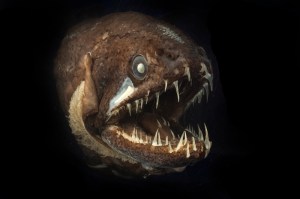
Photo credit: Dr. Julian Finn, Museum Victoria
Every so often we get a glimpse — a transluscent body with a glowing orb hanging off its forehead, or this dragonfish, with teeth on its tongue and jaws that look like they could take your arm off. These missives from our oceans’ depths are as captivating as they are few and far between – the fruit of long, expensive forays to places where humans have no place.
In October, we’ll be able to take a good, long look at the findings of the Census of Marine Life, a decade-long project involving thousands of scientists around the world that will be the most comprehensive list ever compiled of the world’s marine species. To tide us over, the Census has rolled out some of its findings today in the open-access scientific journal PLoS ONE. New data from 25 regions have been combined with historic data to start to answer the simple but elusive question: What lives in the ocean?
We (and by ‘we’ I mean people who know, not me) have only scratched the surface of beginning to answer question. The species with which most of us most familiar — the whales, the sharks, the penguins — are only a tiny fraction of what’s out there. The scientists working on the Census believe that for every one ocean-dwelling species they know about, there are at least four they have yet to discover. Of the 25 areas included into the study released today, the tropics, the deep-seas and the southern hemisphere, and, oddly enough, Japan, house the biggest mysteries: in Antarctica, 39-58% of species are thought to have not been described yet, in South Africa, 38%; in Japan, 70%; in the deep-sea Mediterranean, 75%; and in Australia, 80%. That’s a lot of undiscovered species. (And a fairly good argument to encourage your kids to become marine biologists.)
What’s known is the some 185,000 marine species registered with the World Register of Marine Species, though Census scientists believe that number is now closer to 230,000. (Have a look at an interactive map of new species discovered during the Census here.) What’s also known is finding the rest before some go extinct will be a race against time. Oceans have experienced huge species losses in the last century. The population of the Southern Bluefin tuna, just to give one example, is estimated to have been fished down by over 90% of its original numbers, and it’s not alone. By studying the current diversity, abundance and distribution of what’s living underwater, the Census will create the first and only baseline against which to measure what happens to these populations in the future – where they move, where they thrive, and where they are disappearing.
In theory, that information will help provide a layer of protection to species in trouble — species that are, for instance, being overfished, or whose habitat is being threatened by development. It will be a tool that scientists can use to help make their case against commercial or other interests in arguing for better conservation of a particular marine habitat, helping guide governments and international regulatory bodies toward better informed management policies.
Here are a few interesting takeaways from today’s report:
- The manylight viperfish has been found in a quarter of the oceans included in the study — the most widely distributed fish species out there in the study.
- Because of ship traffic, the Mediterranean has the most invasive species living in its waters, having hitched a ride from the Red Sea via the Suez Canal.
- Some of the most diverse ocean areas, such as China and the Gulf of Mexico, are also the most threatened.
- Crustaceans were at the top of the list of common creatures across the 25 regions. Tunicates were at the bottom.
And if you want to have a look what’s in your oceans, here are species in each of the 25 areas that the Census published information about today.


